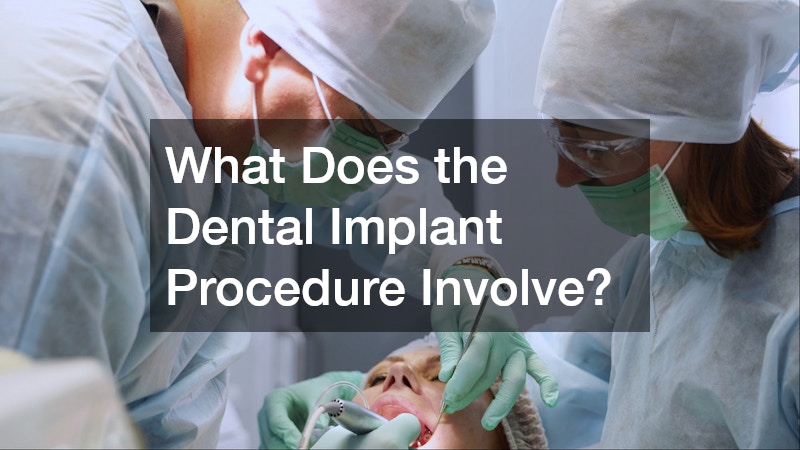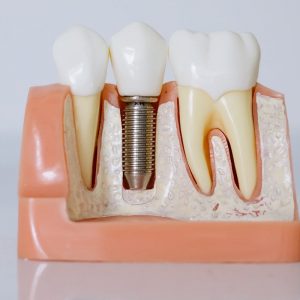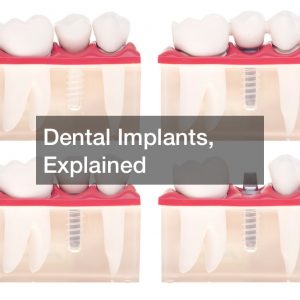Dental implants have become one of the most reliable and long-lasting solutions for replacing missing teeth. This guide explains what dental implants are, how they work, who qualifies for them, and what to expect before, during, and after the procedure. By the end, you’ll have a clear understanding of the process and feel more confident about your dental restoration journey.
What Are Dental Implants?
Dental Implant Components
Dental implants are artificial tooth roots, typically made of titanium, that are surgically placed into the jawbone to support a replacement tooth or bridge. They consist of three main parts: the implant post, which integrates with the bone; the abutment, which connects the post to the crown; and the crown itself, which is the visible portion that resembles a natural tooth. Together, these components provide a permanent and stable foundation for replacement teeth, making dental implants one of the most advanced restorative options available today.
Types of Dental Implants
There are several types of dental implants, and your dentist will determine which is best based on your needs and bone structure. The most common type is the endosteal implant, which is placed directly into the jawbone and is ideal for patients with sufficient bone density. Another option is the subperiosteal implant, which sits under the gum but above the bone, often used for patients who cannot undergo bone grafting. In recent years, innovations such as mini implants and all-on-4 systems have expanded treatment options, allowing more patients to benefit from implant technology.
Benefits of Dental Implants
Dental implants offer several benefits compared to bridges and dentures. They are durable, often lasting decades with proper care. Because implants are anchored directly into the bone, they prevent bone loss and maintain facial structure, something removable dentures cannot do. Additionally, dental implants look, feel, and function like natural teeth, allowing patients to speak and eat comfortably. They also eliminate the need to alter adjacent teeth, which is required for traditional bridges.
Who Is a Candidate for Dental Implants?
Eligibility Criteria
Ideal candidates for dental implants are those with healthy gums and adequate jawbone density to support the implant. Good oral hygiene and overall health are essential for successful results. Patients who do not smoke and have healthy tissue generally have higher success rates, as smoking and poor oral care can interfere with healing and integration.
Assessment and Consultation Process
Before beginning the procedure, your dentist will conduct a thorough examination, including X-rays or 3D scans, to assess bone health and determine the best placement strategy. During the consultation, you’ll discuss treatment goals, expected outcomes, and any potential risks. Your dentist will also review your medical history and medications to ensure you’re a suitable candidate for dental implants.
What Does the Dental Implant Procedure Involve?
Surgery Preparation
Preparation for dental implant surgery typically involves diagnostic imaging, treatment planning, and sometimes preliminary procedures like bone grafting or tooth extraction. Your dentist will provide detailed pre-surgery instructions, including dietary guidelines and medication adjustments.
Surgical Steps
The dental implant procedure is typically performed in stages. First, the dentist places the titanium post into the jawbone. Over the next several months, a process called osseointegration occurs, during which the implant fuses with the bone to create a strong foundation. Once healing is complete, the abutment is attached, followed by the placement of the custom-made crown that matches your natural teeth in shape and color.
Post-Surgery Recovery
Recovery time varies depending on the number of implants and the patient’s overall health. Most people experience mild swelling or discomfort for a few days, which can be managed with over-the-counter medication. Proper oral hygiene, a soft diet, and follow-up visits are crucial for successful healing. Complications are rare when instructions are followed, and most patients resume normal activities within a week.
How Much Do Dental Implants Cost?
Insurance and Financing Options
While some dental insurance plans do not fully cover dental implants, more providers are beginning to include partial coverage for implant-related procedures. Many dental offices offer financing options or payment plans to make the treatment more affordable. It’s a good idea to review your insurance benefits and discuss financing during your consultation.
Comparing Costs with Other Treatments
Although dental implants have a higher upfront cost than dentures or bridges, they are often the most cost-effective long-term solution. Dentures may require replacement every few years, while implants can last decades with proper care, making them a smart investment in your oral health and confidence.
Understanding the dental implants process helps patients make informed decisions about their oral health. From the initial consultation to the final crown placement, each stage is carefully designed to ensure a natural-looking, functional, and lasting result. If you’re considering dental implants, talk to your dentist about your options and take the first step toward a healthier, more complete smile.







